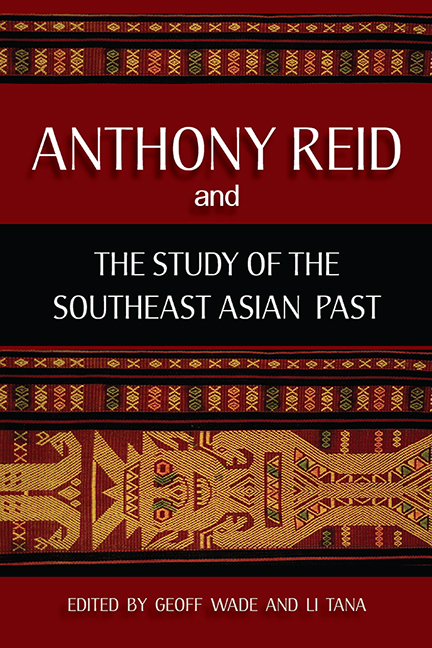Book contents
- Frontmatter
- Contents
- Acknowledgements
- The Contributors
- PART I Introduction
- PART II The Scholarship of Anthony Reid
- PART III Southeast Asia in the World
- PART IV Early Modern Southeast Asia
- 7 Southeast Asian Islam and Southern China in the Fourteenth Century
- 8 Lancaran, Ghurab and Ghali: Mediterranean Impact on War Vessels in Early Modern Southeast Asia
- 9 Weather, History and Empire: The Typhoon Factor and the Manila Galleon Trade, 1565–1815
- 10 Interracial Marriages and the Overseas Family: The Case of the Portuguese Topasses in Timor
- 11 A Note on the Čhām Diaspora in the Ayutthayan Kingdom
- 12 Tongking in the Age of Commerce
- PART V Modern Southeast Asia
- Appendix
- Index
- Plate section
9 - Weather, History and Empire: The Typhoon Factor and the Manila Galleon Trade, 1565–1815
from PART IV - Early Modern Southeast Asia
Published online by Cambridge University Press: 21 October 2015
- Frontmatter
- Contents
- Acknowledgements
- The Contributors
- PART I Introduction
- PART II The Scholarship of Anthony Reid
- PART III Southeast Asia in the World
- PART IV Early Modern Southeast Asia
- 7 Southeast Asian Islam and Southern China in the Fourteenth Century
- 8 Lancaran, Ghurab and Ghali: Mediterranean Impact on War Vessels in Early Modern Southeast Asia
- 9 Weather, History and Empire: The Typhoon Factor and the Manila Galleon Trade, 1565–1815
- 10 Interracial Marriages and the Overseas Family: The Case of the Portuguese Topasses in Timor
- 11 A Note on the Čhām Diaspora in the Ayutthayan Kingdom
- 12 Tongking in the Age of Commerce
- PART V Modern Southeast Asia
- Appendix
- Index
- Plate section
Summary
Introduction
This paper describes and analyses how the Manila galleon trade and Spain's efforts to colonize the Philippines were frequently placed in jeopardy by the uncontrollable and unpredictable power of cyclonic storms. It highlights the significance of the devastating impact of typhoons on the history of the Spanish galleons trading between Manila and Acapulco as an unexplored aspect of the history of the Philippines under Spain. The Manila galleon trade was one of the most persistent, perilous and profitable trans-oceanic enterprises in the annals of colonial economic history. Between 1565 and 1815, the galleons or “China ships”, the largest and wealthiest merchant ships of their age, carried the treasures of China and other parts of Asia to the West via Mexico. To the peoples of the Philippines, China and Japan they were the “silver argosies,” returning from Mexico with silver ingots, Mexican and Peruvian pesos and the manufactured goods of Europe. However, more than forty galleons were lost over the course of 250 years, many of them to typhoons and storms at sea. The sudden loss of these huge vessels in the storm-tossed waters between the Philippines and Mexico had dire economic and social consequences in the seventeenth and eighteenth centuries as the Spanish colony was utterly dependent on a financial administrative grant in aid (the situado) and trade with Mexico.
Founding Manila
Ferdinand Magellan, the Portuguese navigator who sailed under the flag of Castille y Leon, in an effort to make the vision of a new Spanish empire over the Pacific a reality, set out from Spain in 1519 with five ships and a complement of 264 crew to find a way to the fabled Spice Islands by sailing westward. At a time when few believed in the theory of the spherical form of the earth, the renowned mariner sought a passage by the south of America in order to circumnavigate the globe. On this first epic-making voyage around the world, Magellan successfully navigated across the Pacific and sighted the island of Samar on 16 March 1521. A year later, and three years after the expedition set out from Spain, only the ship Victoria returned, with just 18 men, but its hold was filled with 26 tons of cloves.
- Type
- Chapter
- Information
- Anthony Reid and the Study of the Southeast Asian Past , pp. 183 - 220Publisher: ISEAS–Yusof Ishak InstitutePrint publication year: 2012

